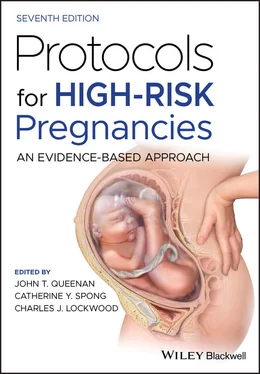9 PART 4: Obstetric Problems PROTOCOL 37: Cervical Insufficiency Overview Diagnosis Management in singleton pregnancy Surgical technique for cerclage placement Management in twin pregnancy Suggested reading PROTOCOL 38: Nausea and Vomiting Clinical significance Diagnosis and pathophysiology Differential diagnosis Treatment Complications Recurrence risk Conclusion Suggested reading PROTOCOL 39: Fetal Death and Stillbirth Overview Pathophysiology and etiology Diagnosis Treatment Diagnostic evaluation Follow‐up Suggested reading PROTOCOL 40: Abnormal Amniotic Fluid Volume Overview Physiology of normal amniotic fluid volume Amniotic fluid production Amniotic fluid removal Oligohydramnios Polyhydramnios Suggested reading PROTOCOL 41: Fetal Growth Restriction Definition and clinical significance Etiology Screening Surveillance Management Outcome Prevention Conclusion Suggested reading PROTOCOL 42: Rh and Other Blood Group Alloimmunizations Overview Pathophysiology Management of the first alloimmunized pregnancy (Figure 42.1) Management of a subsequent alloimmunized pregnancy Treatment Outcome and follow‐up Prevention Conclusion Suggested reading PROTOCOL 43: Preterm Labor Clinical significance Pathophysiology Diagnosis Treatment Complications Follow‐up Conclusion Suggested reading PROTOCOL 44: Prevention of Preterm Birth Clinical significance Pathophysiology and antecedents of preterm birth Management Conclusion Suggested reading PROTOCOL 45: Premature Rupture of the Membranes Overview Pathophysiology Clinical implications Diagnosis Evaluation Management Special circumstances Prevention of recurrent preterm PROM Suggested reading PROTOCOL 46: Indicated Late‐Preterm and Early‐Term Deliveries Clinical significance Pathophysiology Diagnosis Management Complications Follow‐up and prevention Conclusion Suggested reading PROTOCOL 47: Chorioamnionitis Overview Definitions and clinical presentation Epidemiology Pathophysiology Risk factors Management Fever of unknown origin Isolated intrapartum maternal fever Complications Prevention Conclusion Suggested reading PROTOCOL 48: Third‐Trimester Bleeding Introduction Etiology Work‐up of third‐trimester bleeding General management considerations Potential complications Conclusion Suggested reading PROTOCOL 49: Amniotic Fluid Embolism Overview Pathogenesis Clinical presentation Management Published guidelines Conclusion Suggested reading PROTOCOL 50: Preeclampsia Overview Pathophysiology Diagnosis Management Initial evaluation Gestational hypertension and preeclampsia without severe features Preeclampsia with severe features Complications of preeclampsia and HELLP Follow‐up and maternal counseling Suggested reading
10 PART 5: Labor and Delivery PROTOCOL 51: Elective Induction of Labor Overview Cervical ripening agents Labor‐inducing procedures and agents Failed induction Conclusion Suggested reading PROTOCOL 52: Electronic Fetal Heart Rate Monitoring Overview Physiology of fetal heart rate patterns Fetal oxygenation and its interruption A simplified, standardized approach to management Conclusion Suggested reading PROTOCOL 53: Breech Delivery Overview Diagnosis Management Breech delivery at cesarean Conclusion Suggested reading PROTOCOL 54: Vaginal Birth After Cesarean Overview Prelabor counseling Management of labor and delivery Uterine rupture Conclusion Suggested reading PROTOCOL 55: Placenta Accreta Spectrum Overview and clinical significance Pathophysiology and risk factors Diagnosis Complications Management Prevention Follow‐up Conclusion Suggested reading PROTOCOL 56: Shoulder Dystocia Overview Pathophysiology and diagnosis Management Extraordinary maneuvers Documentation Suggested reading PROTOCOL 57: Twins, Triplets, and Beyond Clinical significance Pathophysiology Placentation Diagnosis Management Delivery Complications Multifetal pregnancy reduction Selective termination Conclusion Suggested reading PROTOCOL 58: Postpartum Hemorrhage Clinical significance Definition Pathophysiology Diagnosis Management Complications Follow‐up Reporting Prevention Conclusion Suggested reading
11 Appendix A: Evaluation of Fetal Health and Defects
12 Index
13 End User License Agreement
1 Chapter 1 Table 1.1 Four components of brief intervention
2 Chapter 3 Table 3.1 Medication choice for treatment of opioid use disorder in pregnancy... Table 3.2 Buprenorphine initiation protocol example Table 3.3 Risks and protective factors for neonatal abstinence syndrome (NAS)
3 Chapter 5 Table 5.1 Nuchal translucency (NT) measurement criteria of the Nuchal Translu... Table 5.2 Sonographic findings associated with trisomies 21, 18, and 13
4 Chapter 6 Table 6.1 Indications for fetal echocardiography Table 6.2 Standard fetal echocardiographic views and what to see Table 6.3 AIUM recommended components of detailed fetal echocardiographic exa...
5 Chapter 8 Table 8.1 Fetal biophysical profile
6 Chapter 10 Table 10.1 Recommended carrier screening for individuals of Ashkenazi Jewish ...
7 Chapter 11 Table 11.1 Changes in laboratory values in pregnancy Table 11.2 Oral preparations for therapy of iron deficiency anemia Table 11.3 Intravenous preparations for therapy of iron deficiency anemia
8 Chapter 14 Table 14.1 2019 SLE Criteria from the European League against Rheumatism and ...Table 14.2 Differentiating a lupus flare from preeclampsia
9 Chapter 16Table 16.1 Inherited thrombophilia and the risk of venous thromboembolism (VT...Table 16.2 Testing for inherited thrombophiliaTable 16.3 Guidelines for the prevention of VTE during pregnancy in women wit...Table 16.4 Protocols for anticoagulation
10 Chapter 17Table 17.1 Physiological cardiac changes in pregnancyTable 17.2 Etiology of valvular heart diseaseTable 17.3 Risk stratification schema for maternal heart disease in pregnancyTable 17.4 Modified WHO pregnancy risk classification system by cardiac condi...Table 17.5 Stages of progression of VHDTable 17.6 Pregnancy‐associated maternal mortality in valvular heart diseaseTable 17.7 Select cardiac medications with obstetric implicationsTable 17.8 Hemodynamic effects of VHD, effects of pregnancy, and management o...Table 17.9 New York Heart Association (NYHA) risk stratificationTable 17.10 Select obstetric medications with cardiac implicationsTable 17.11 Special populations requiring antibiotic prophylaxis during labor...Table 17.12 Infective endocarditis prophylactic antibiotic regimens in pregna...
11 Chapter 18Table 18.1 Clinical and echocardiographic features of variants of cardiomyopa...
12 Chapter 19Table 19.1 Inherited thrombophilia, personal history of VTE and pregnancy VTE...Table 19.2 Fetal radiation exposure of various ionizing modalities in radsTable 19.3 Timing of neuraxial anesthesia in relation to pharmacological anti...Table 19.4 Antepartum anticoagulationTable 19.5 Postpartum anticoagulationTable 19.6 Anticoagulation regimen definitions
13 Chapter 20Table 20.1 Classification of chronic kidney diseaseTable 20.2 Classification of CKDTable 20.3 Pregnancy‐related outcomes by CKD stageTable 20.4 Specific kidney diseases and pregnancy
14 Chapter 21Table 21.1 Institute of Medicine recommendations for total and rate of weight...Table 21.2 Obesity‐related maternal/fetal risksTable 21.3 Management considerations for the obese gravida
15 Chapter 22Table 22.1 Glycosylated hemoglobin levelsTable 22.2 National Academy of Medicine weight gain recommendations for pregn...Table 22.3 Glucose control during first stage of laborTable 22.4 Venous plasma concentrations for positive diagnosis of diabetes me...Table 22.5 Values for venous plasma glucose
16 Chapter 23Table 23.1 Diagnosis of thyroid disorders
17 Chapter 24Table 24.1 Nucleos(t)ide analogues recommended for treatment of chronic hepat...
18 Chapter 25Table 25.1 Long‐term control medications for asthma during pregnancyTable 25.2 Estimated comparative daily adult dosages for inhaled corticostero...Table 25.3 Recommendations for preferred step therapy for asthma during pregn...Table 25.4 Classification of asthma control during pregnancy aTable 25.5 Asthma biologicsTable 25.6 Pharmacological management of acute asthma during pregnancy
Читать дальше












